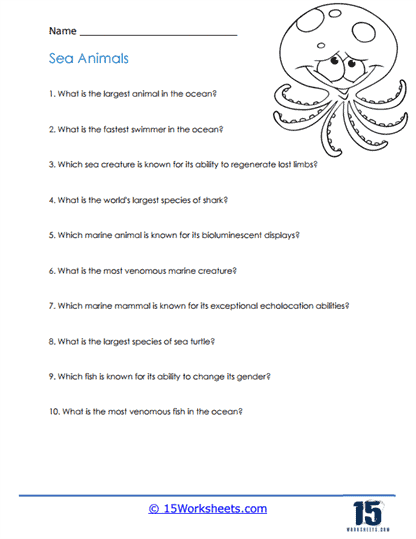Sea Animals

Worksheet Description
Sea animals, often referred to as marine animals or marine life, encompass a vast and diverse group of organisms that inhabit the world’s oceans and seas. These creatures have adapted to the unique challenges and opportunities presented by their underwater environments, making them distinct from their terrestrial counterparts. In this exploration, we will delve into the characteristics, diversity, adaptations, and ecological importance of sea animals.
Sea animals exhibit remarkable diversity, ranging from tiny planktonic organisms to massive marine mammals. This group includes fish, crustaceans (such as crabs and lobsters), mollusks (like octopuses and squids), marine reptiles (like sea turtles), and marine mammals (such as dolphins, whales, and seals). Additionally, numerous invertebrates, from corals to sponges, thrive in marine ecosystems.
Sea animals have evolved a wide array of adaptations to thrive in their watery habitats. These adaptations can include streamlined body shapes for efficient swimming, gills for extracting oxygen from water, and specialized appendages for locomotion and capturing prey. Some marine animals have developed unique features like bioluminescence for communication and camouflage for protection.
Reproduction strategies among sea animals vary considerably. Many marine species release eggs and sperm into the water, where fertilization takes place externally. Some animals, like sea turtles, return to specific beaches to lay their eggs. Others, such as some sharks and rays, give birth to live young. The life cycles of marine organisms can also be complex, involving various larval stages before reaching adulthood.
Sea animals play critical roles in marine ecosystems. They occupy various niches in food webs, acting as both predators and prey. For instance, large marine mammals like whales feed on plankton, while sharks and predatory fish maintain the balance of marine populations by preying on smaller fish. Filter-feeding animals, like bivalve mollusks, help maintain water quality by filtering particles and algae from the water.
Marine animals provide a range of ecological services. Coral reefs, formed by tiny coral polyps, offer habitat to numerous species and protect coastlines from erosion. Mangroves, where aquatic and terrestrial ecosystems meet, are vital breeding grounds for many marine species and serve as nurseries for fish. Sea otters, by consuming sea urchins, help protect kelp forests, which are essential marine habitats.
